Key takeaways:
- Covers evoke nostalgia and foster emotional connections, making music more impactful through personal interpretations.
- Performing covers enhances audience engagement by creating shared experiences and moments of reflection.
- Selecting songs with emotional resonance and recognizability is crucial for authentic performances and audience connection.
- Personal interpretation and unique style in covers can transform familiar songs, making them feel fresh and deeply resonant.
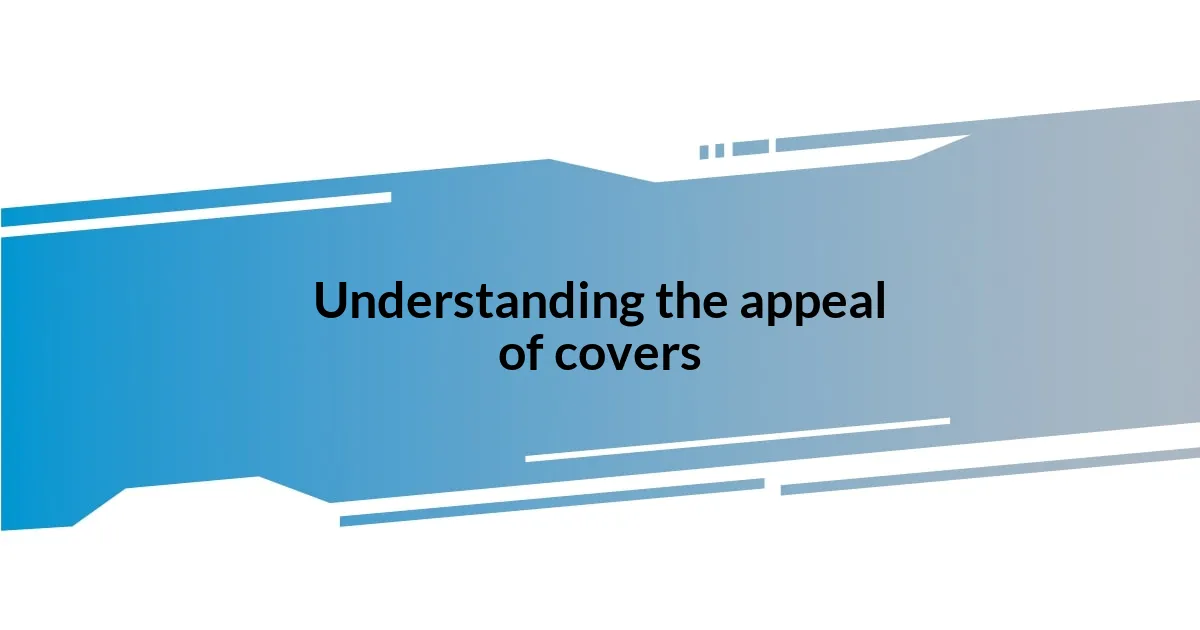
Understanding the appeal of covers
Covers have a unique charm that draws listeners in, almost like a warm hug from a familiar friend. I remember the first time I heard a cover of one of my favorite songs—it sparked a flood of memories. The artist’s interpretation gave me a fresh perspective, reminding me just how powerful music can be in connecting us to shared experiences.
What captivates me is how covers breathe new life into songs we already know. Have you ever found yourself humming an old tune, only to hear a well-crafted cover that makes you appreciate it in a whole new way? That’s the magic of interpretation—each artist brings their own emotion and flavor, transforming the original while honoring its essence.
I find it fascinating that covers can serve as a bridge across generations. For instance, my niece may have never heard the classic hits from my childhood, yet when a modern artist reimagines one of those tracks, it introduces her to an unforgettable piece of music history. It’s like handing down a favorite book; the cover is a new edition, but the story remains timeless.
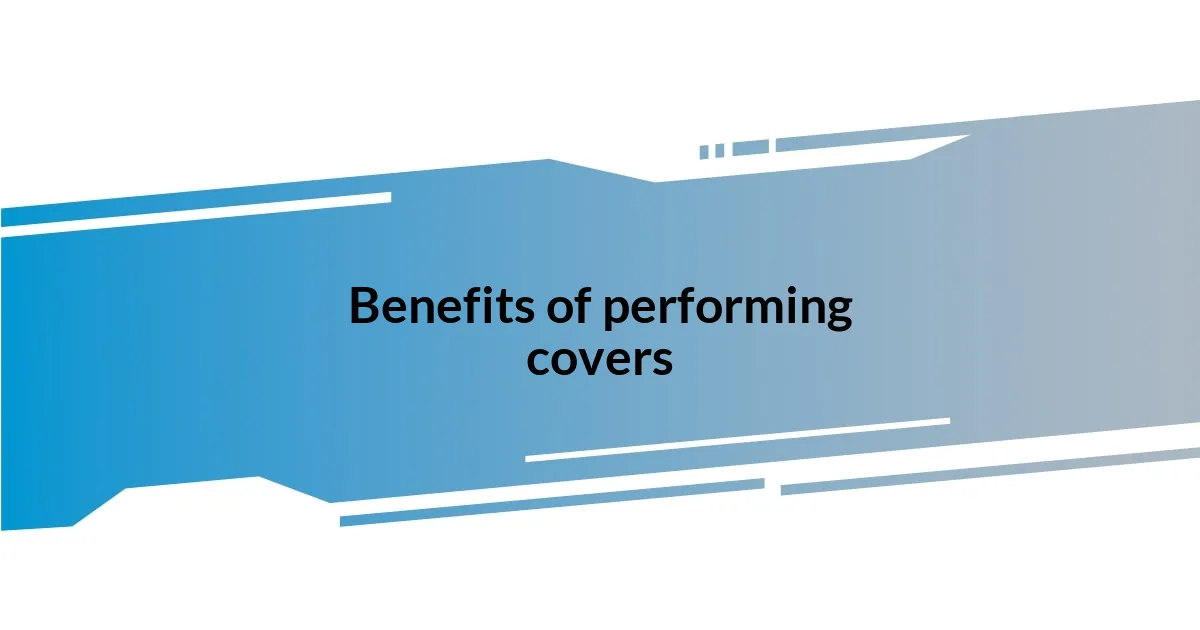
Benefits of performing covers
Covers can significantly broaden an artist’s audience. When I decided to perform a cover of a popular song at an open mic night, I quickly noticed how familiar tunes encouraged engagement. The crowd responded differently—more cheers, more faces lighting up with recognition. It’s like when you share a beloved story with friends; the excitement is palpable, creating an instant connection.
Another benefit I’ve found from doing covers is the opportunity for personal growth. Each time I reinterpret a song, I learn something new about my own vocal range and style. I remember practicing a unique take on a classic rock ballad. With each rehearsal, I wasn’t just covering a song; I was discovering aspects of my voice I didn’t know I possessed. This process is invigorating and helps cultivate confidence on stage.
Lastly, performing covers allows for creative exploration within established frameworks. I enjoy mixing genres—like transforming a pop hit into a soulful ballad. This experimentation not only showcases my musical range but also resonates with audiences in surprising ways. Every time I step outside my comfort zone, I feel a rush of adrenaline and joy, bridging my expression with the audience’s expectations.
| Benefit | Description |
|---|---|
| Audience Engagement | Familiar songs draw listeners in and create instant connections. |
| Personal Growth | Covering songs challenges artists to develop their style and vocal skills. |
| Creative Exploration | Experimenting with genres leads to unique interpretations and performances. |
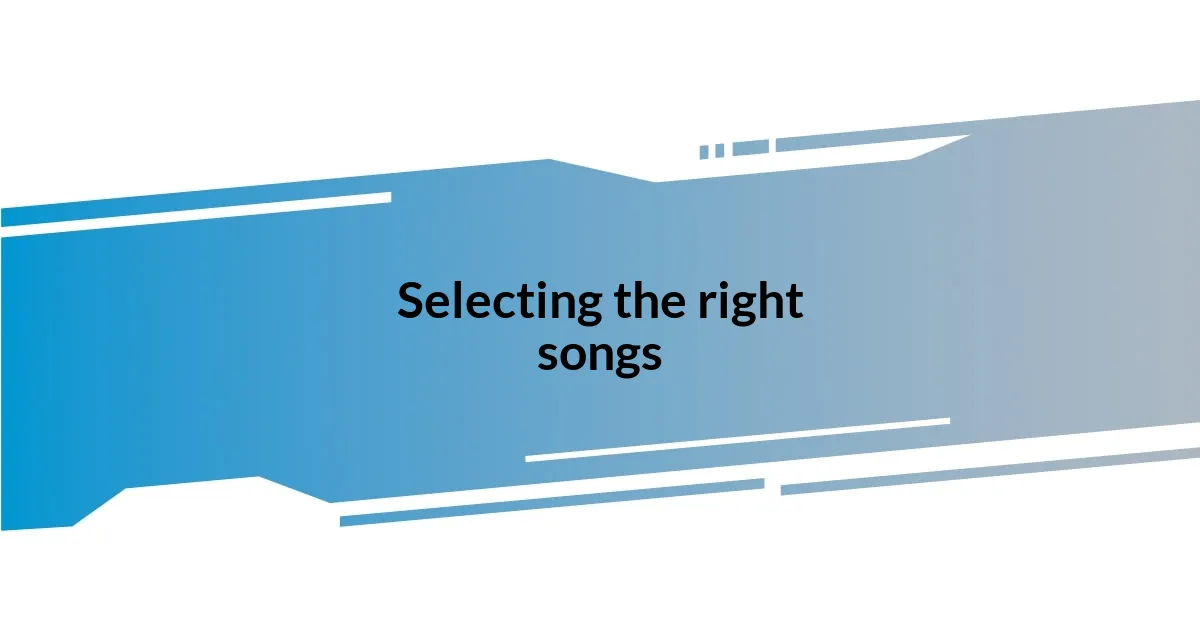
Selecting the right songs
Selecting the right songs for covers can be a game-changer. I remember my early days of picking tunes; I’d often choose songs that resonated with me deeply. It’s crucial to select tracks that spark an emotional connection, as that connection translates into a more authentic performance. When I cover songs that hold personal significance, the audience feels that passion, making the entire experience more engaging.
Here are a few factors I consider when selecting songs:
- Recognizability: Familiar tunes can ignite excitement. A song most people know is likely to captivate the crowd.
- Emotional Resonance: Choosing songs that tell a story or evoke feelings connects you to your audience on a deeper level.
- Vocal Compatibility: It’s important to select songs that align with your vocal strengths. I often gravitate towards pieces that allow me to showcase my range without feeling constrained.
- Genre Exploration: I love experimenting with different genres. A folk song transformed into an upbeat pop hit may surprise listeners and create a memorable experience.
- Personal Connection: I’ve found that the songs I love most often resonate with others too. If a song has impacted me, it’s likely to touch someone else.
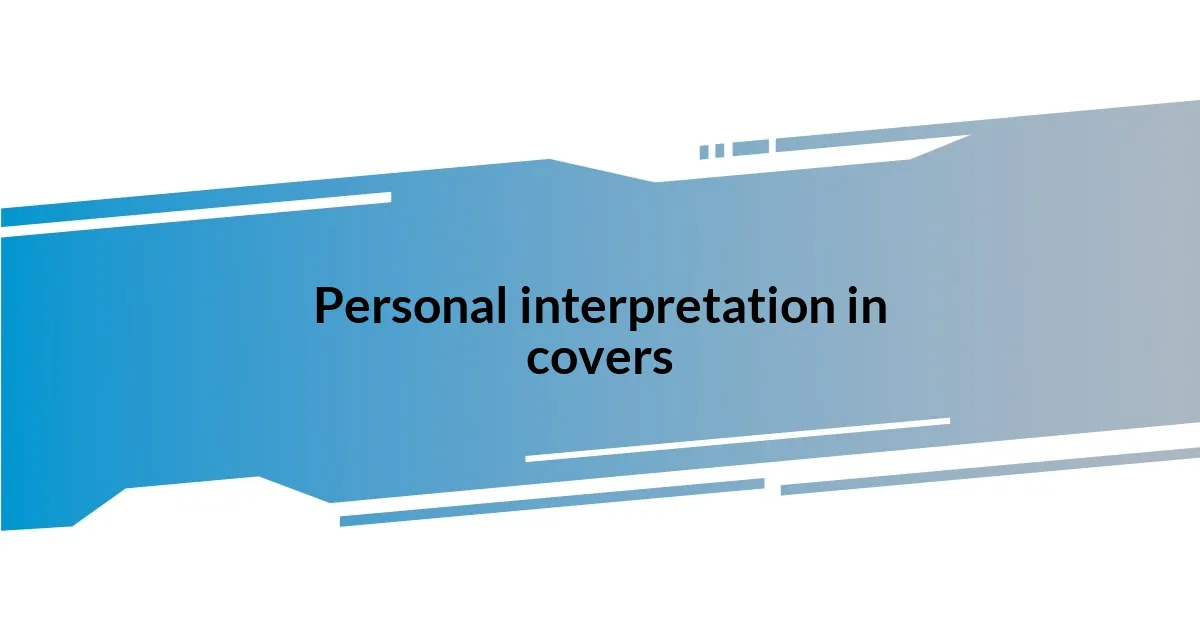
Personal interpretation in covers
When it comes to performing covers, personal interpretation is key. I recall a time when I decided to put my spin on a modern pop song, transforming it into an acoustic version that highlighted my emotional connection to the lyrics. The audience’s reaction was incredible; they felt the rawness of my interpretation, which made me realize just how powerful a unique take can be. It’s about infusing your own story and feelings into the music, breathing new life into something familiar.
I often ask myself, “What makes a cover memorable?” For me, it’s the little personal touches. When I covered a classic love ballad, I added a few unexpected pauses and vocal runs that reflected my feelings at that moment. The result wasn’t just another rendition; it became a moment of shared vulnerability. It’s fascinating how these small decisions can resonate deeply with listeners, reminding them of their own experiences.
Every time I perform a cover, I view it as a conversation with the original artist. I think about their intent and then filter it through my own lens. I find that this dialogue enhances my performance. For instance, when I conveyed a sense of longing in a song that’s generally upbeat, it created a surprising yet captivating moment for the audience. Isn’t it intriguing how a song can shift meanings with just a slight change in delivery? This personal interpretation can truly transform a familiar piece into something entirely new and meaningful.
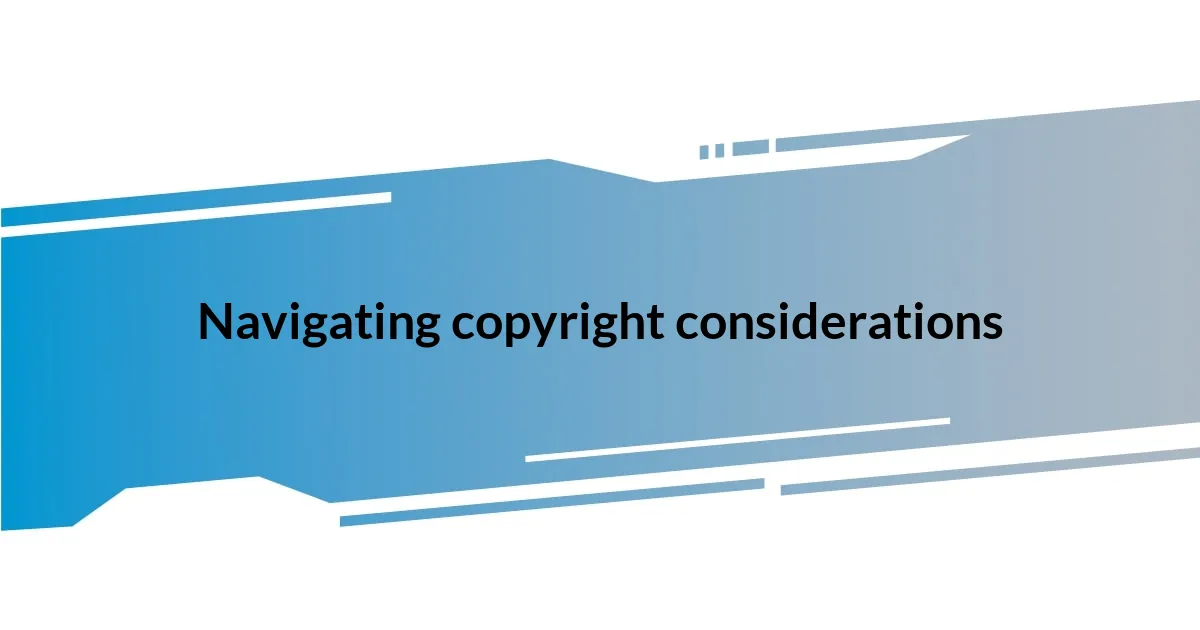
Navigating copyright considerations
When diving into the world of covers, understanding copyright considerations is essential. I recall a gig where I enthusiastically performed a beloved classic, only to later realize I hadn’t secured the proper permissions. This moment taught me that even the most well-intentioned cover can lead to complications if copyright laws aren’t respected. Navigating these legal waters can be tricky, but it’s vital for any performer wanting to share their interpretation legally.
One important aspect to keep in mind is that not all covers are treated equally. For example, when covering a song, the method of distribution matters significantly. I’ve discovered that streaming platforms often have agreements that cover certain songs, which can simplify things if you’re sharing your performance online. However, if you’re considering a live performance, obtaining a mechanical license—and sometimes a synchronization license if you’re pairing the song with video—is crucial. It makes me think: how many aspiring artists might overlook this step in their excitement?
Finally, I find it helpful to remember that cover songs can foster creativity in unexpected ways, even within copyright frameworks. I once participated in a tribute show that required us to obtain clearances in advance for any songs we planned to use. While it seemed like a hassle at first, understanding the muscle behind rights and permissions inspired me to choose songs that not only challenged me but also compensated the original artists fairly. This shift in perspective made me appreciate the artistry behind the original work even more. How can we respect and celebrate the creators who came before us while still bringing our unique flair to their songs?
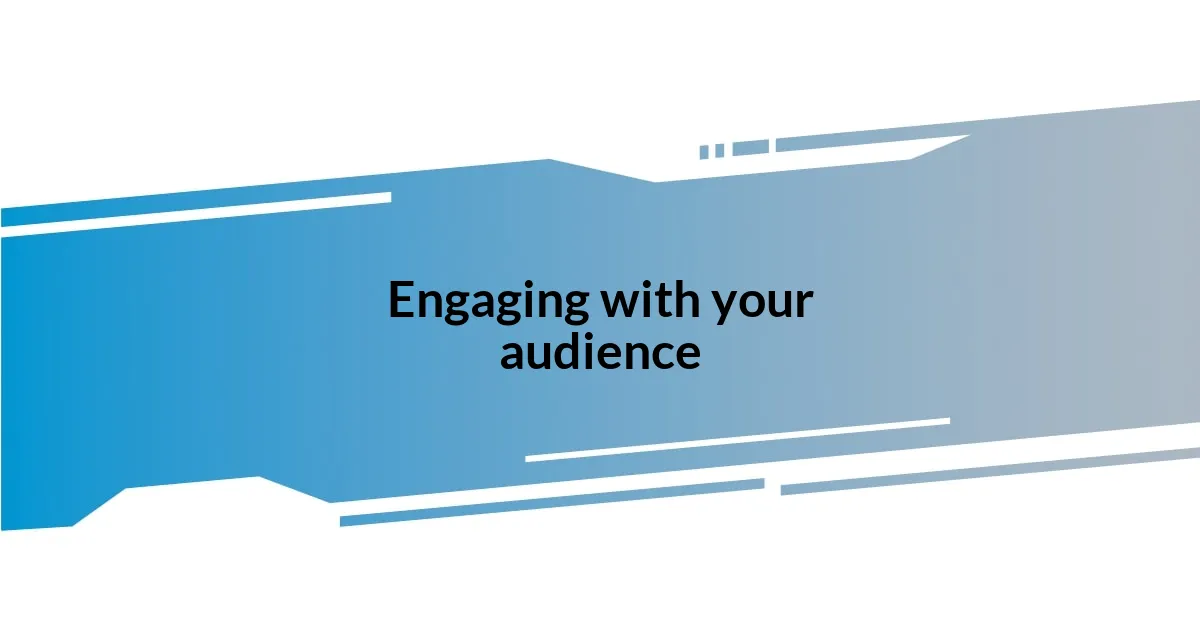
Engaging with your audience
Engaging with your audience is more than just performing; it’s about creating a connection. One time, during a small open mic night, I noticed a couple in the crowd, eyes locked on me, swaying gently to my rendition of a poignant ballad. You could feel the palpable connection; their expressions mirrored the emotions I was trying to convey. It hit me that music could transform a simple gathering into a shared experience, where our stories intertwined, even if only for a few fleeting moments.
I also believe that storytelling plays a crucial role in engaging an audience. When I introduced a cover of a song that had meant a lot to me during a tough period, I shared the backstory. The way listeners leaned in, hanging on to every word, reminded me of how much people crave authenticity. I often ask myself: How can a song be more than just notes and lyrics? When performing, I strive to ensure that my interpretation resonates with their experiences. It’s fascinating how a few heartfelt words can make a cover feel relatable and invite everyone to reflect on their own journey.
Every performance is an opportunity to invite the audience into my world. I recall a moment when I completely changed the arrangement of a popular song, shifting it from upbeat to a somber tone. To my surprise, it sparked an emotional response in the audience that I hadn’t anticipated. There’s something deeply rewarding about seeing faces light up with recognition, or even witnessing someone wipe away a tear. This made me realize that engaging your audience is about evoking feelings and prompting them to reflect. After all, isn’t that the essence of music—a chance to share, connect, and heal together?
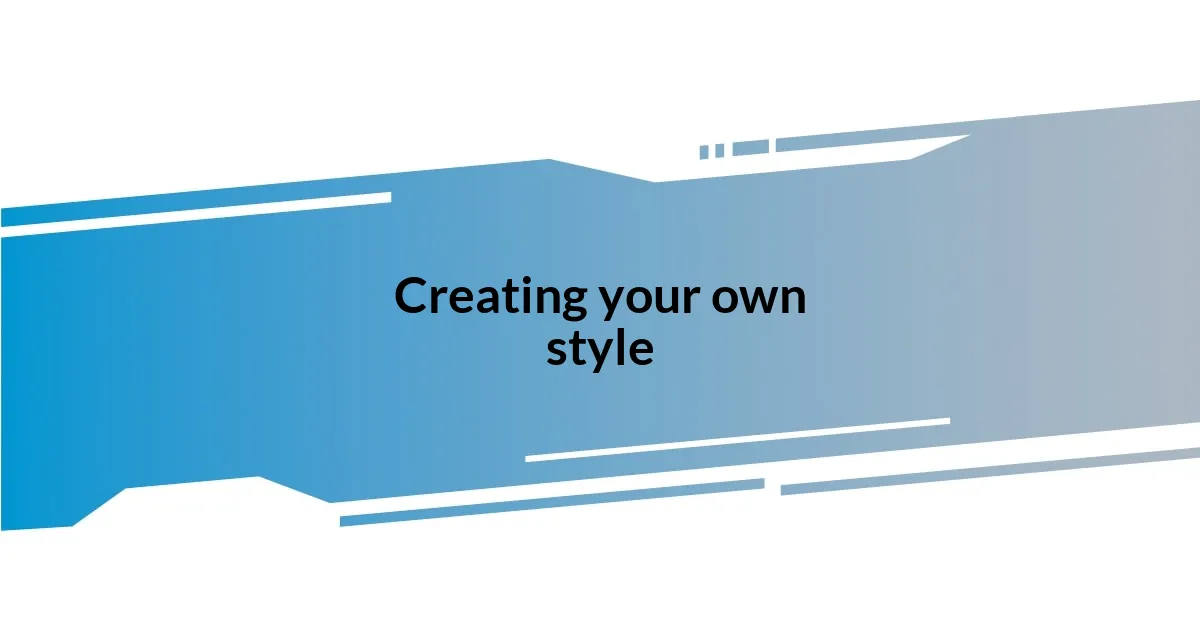
Creating your own style
Creating your own style when performing covers is essential for standing out in a crowded music scene. I remember a time when I decided to experiment with an acoustic version of a pop hit I loved. Instead of sticking to the original arrangement, I slowed it down and infused a bit of jazz. The surprise on the audience’s faces transformed into delight as they heard something familiar yet refreshingly new. It made me realize that my ability to reinterpret a song could draw people in and invite them to listen with fresh ears.
Developing a personal style also means imbuing your performance with your own emotions and experiences. I once took a well-known breakup anthem and weaved in my story of vulnerability and healing. As I strummed the opening chords, I felt a wave of vulnerability wash over me, and I could see it resonating with others in the crowd. It makes me wonder—how often can a cover become a powerful mirror reflecting shared feelings of love and loss? That night, I discovered that authenticity in interpreting a cover can turn mere notes into an emotional journey that captivates listeners.
It’s a continuous process of self-discovery as you figure out what elements truly express you. I often change lyrics or adjust tempos to see how that alters the emotional impact. There was a moment when I performed a cover at a family gathering and included an extra verse that reflected my own experiences. The room went silent, and for a moment, it felt like I had created a new song altogether. Have you ever thought about how a slight change in delivery can create a whole new narrative around a song? It taught me that making a cover your own doesn’t just honor the original; it evolves the conversation around it into something deeply personal.